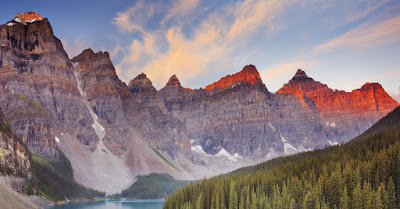G |
O forth; to them that are in darkness, Shew yourselves. They shall feed in the ways, and their pastures shall be in all high places. 10 They shall not hunger nor thirst; neither shall the heat nor sun smite them: for he that hath mercy on them shall lead them, even by the springs of water shall he guide them. 11 And I will make all my mountains a way, and my highways shall be exalted. (Isaiah 49:9-11)
Mount Everest is the tallest mountain on earth (as physical mountains go) at 29,035 ft above sea level. Sir Edmund Hillary and Tanzing Norgay were the first to mount the summit of Everest on 29 May 1953. Since that time, hundreds – not thousands – have followed in the steps of those two men in conquering that worldly summit. But the mountains of men’s vain labors are less than mole hills compared to the Himalaya’s of God. His mountains are described as moral and spiritual landmarks for His people. There are spiritual mountains to which the Christian can point in his Christian walk – the Bible stories and hymns he remembers as a child, his baptism and confirmation to which he can point back, the moments of crises that seemed to spell doom but was turned to victory in Christ. But there are other mountains that are referred to as the Mountains of God. There are seven distinct mountains that we may refer to as the Mountains of the Lord. These point to the Way of the Lord in dealing with His people each have a symbolic meaning to us. Let us examine these Seven Mountains:
Mount Moriah
To me, the foremost mountain, even if the smallest in stature, is Mount Moriah. It is the mountain of redemption upon which the Temple was constructed and where our Lord was crucified. When Abraham approached Mount Moriah, Isaac asked, Father, where is the lamb for the offering? to which Abraham responded, My son, God will provide Himself a Lamb for the offering. And in the fullness of time, God DID provide Himself a Lamb for the offering in the Person of His only Begotten Son, Jesus Christ – the Lamb of God! Abraham called Moriah, Jehovah-Jireh, meaning God will provide.
Mount Horeb
The Mountain of Mercy and Revelation. It is the Mount upon which Moses was confronted with the burning bush, but it is also the mountain upon which God mercifully provided an endlessly flowing fountain of water from the split Rock which represented Christ.
Mount Sinai
This is the Mountain of Law and judgment. God gave to Moses the Ten Commandments written with the very finger of god atop this mountain. Any who touched the mountain during God’s presence would be stricken with death. The same is true of the Law. All who hope to gain salvation by obedience to the Law (impossible) will be stricken with death. Interestingly, and thankfully, the mountain of law and judgment comes behind the mountain of mercy (Horeb). Mercy trumps law.
Mount Hor
The mountain of transition. It was upon this mountain that Aaron was stripped of his priestly vestments, which were then given to Eleazar, and died upon Mount Hor. Aaron, like Moses, was not allowed to enter the Promised Land because of the failure to credit the Lord with the flowing waters from the rock of Meribah at Mount Horeb. He died upon Mount Hor. Mount Hor is the Mount of final things. We will all be relieved of our earthly garments and take up the White Robe purchased for us by Christ at our passing.
Mount Nebo
This is the mountain of vision from which Moses was taken up to view the Promised Land. He, like Aaron, was not allowed to cross over Jordan to the Promised Land, but was allowed to view it from the peak of Mount Pisgah thereof. Moses died on Mount Nebo and secretly buried by the Lord in the Valley of Moab. The next time we find Moses in Scripture was atop the Mount of Transfiguration conversing with our Lord – a far greater mountain than Mount Nebo and truly in the Land of Promise.
Mount Zion
This is the mountain of final victory and joy. But upon mount Zion shall be deliverance, and there shall be holiness; and the house of Jacob shall possess their possessions. (Obadiah 17) And I looked, and, lo, a Lamb stood on the mount Sion, and with him an hundred forty and four thousand, having his Father’s name written in their foreheads. (Revelations 14:1)
Mount Olivet
This is the way to Christ and the way of prayer. And as he sat upon the mount of Olives, the disciples came unto him privately, saying, Tell us, when shall these things be? and what shall be the sign of thy coming, and of the end of the world? (Matt 24:3) Jesus often resorted to this mountain for prayer.(see John 8:1)
The mountains of the Lord are the high places of our spiritual journey. We all have our Mountains of the Lord to confront, but these are blessings in the climbing: Thy mercy, O Lord, is in the heavens; and thy faithfulness reacheth unto the clouds. Thy righteousness is like the great mountains; thy judgments are a great deep: O Lord, thou preservest man and beast. (Psalm 36:5-6)

No comments:
Post a Comment